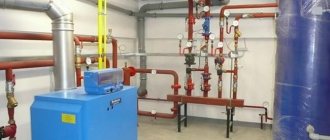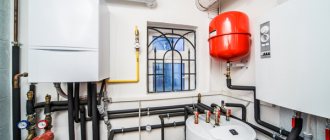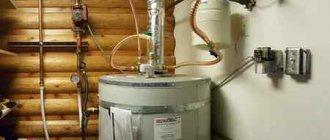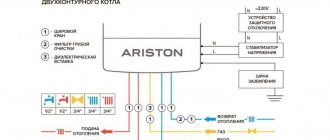Have you already experienced the harmful effects of limescale?
Washing machine, coffee machine, gas boiler... Which of them became the latest victim of limescale?
Do you want to know more - what is scale and how to deal with it?
Read our article! We have been dealing with the issue of protecting equipment from scale for a long time and are confident that our knowledge will be useful to you!
In the photo: samples of scale from pipes taken by us for research
Why is scale dangerous?
Scale has extremely low thermal conductivity.
For example: the thermal conductivity of steel is 39 kcal/m*hour*deg, and the thermal conductivity of scale is only 0.1 kcal/m*hour*deg. The difference is almost 400 times!
This means that when a boiler, kettle or heating element is operating, they have to spend more gas or electricity to heat and evaporate the liquid.
And that's not so bad.
Scale deposits damage equipment and devices, making their operation impossible!
Lime deposited on the surfaces of washing machines leads to burnout of the heating element. Scale deposited in the nozzles of coffee machines makes it impossible to supply liquid. Scale that clogs the coil of a gas boiler leads to its leakage and expensive repairs.
Deposits that arise during the operation of industrial boilers can lead to rupture of pipes and an emergency!
Due to our line of work, we come across various boilers every day and sometimes we are surprised at how careless people who operate high-power gas boilers are...
In the picture you can see that the boiler pipe is completely clogged with scale. Water does not pass through it, the pipe is constantly overheated and this can lead to an explosion! However, such a boiler continued to work...
In the photo: scale in the pipe of the boiler DE-10-14
Thus, the occurrence of scale in heating equipment leads to the following negative consequences:
- Excessive consumption of fuel and electricity;
- Accelerated wear and tear of equipment;
- Impossibility of implementing the technological process;
- The likelihood of an emergency;
Types of scale
The number of chemical elements from which scale is formed is quite diverse and, at a minimum, it is classified into the following types:
- carbonate scale (carbon dioxide salts of calcium and magnesium - CaCO3, MgCO3);
- sulphate scale (CaSO4);
- silicate scale (silicic acid compounds of calcium, magnesium, iron, aluminum).
Over 15 years of operation, our company has accumulated a significant number of scale samples from different parts of Russia. We examined more than 1000 scale samples and determined their chemical composition.
Pictured: the original scale sample and its crushed form for research
Based on the results of the study, we found that the scale content in the vast majority of samples contains the following elements:
Ca/Mg - from 87 to 96%
Fe - from 0.06 to 7.5%
SiO2 - from 0.02 to 1.8%
Is it possible to determine its chemical composition by the appearance of scale?
Based on our studies of more than 100 scale samples, we determined that:
It is not possible to unambiguously determine the chemical composition of scale by its appearance!
Too many factors affect the color and consistency of scale - the initial composition of the water, temperature, pressure at which scale forms. In addition, scale contains many more elements, which are very small in quantity, but they affect the color and character of the deposits.
For example:
Pictured: scale samples of different colors and consistencies
These images show sediments that differ significantly in color and physical structure. Surprisingly, these deposits have almost the same chemical composition! However, the different temperatures and pressures at which these scale samples formed resulted in such differences in color and texture!
At what temperature does scale form?
Scale begins to form at temperatures of 40°C and above.
We found fairly detailed information about the temperature and rate of scale formation in hot water preparation devices in the book by Vladislav Shaflik “Modern hot water supply systems”, Kyiv, “Taki Spravy”, 2010.
The table shows data on the dependence of the rate of scale formation on water hardness and temperature.
In the figure: data on the rate of scale formation depending on temperature
How to detect?
The presence of scale during heating with a heating boiler unit can be visualized by dismantling and partially disassembling it. However, in this case the warranty and service are lost. In addition, it is necessary to involve specialists to prevent damage to the structure.
Another detection method can be called indirect, since it can be implemented without disassembling the boiler itself. To do this, you need to turn off the boiler, wait until it cools down, and then unscrew the nut on the heating circuit pipe, drain the water and examine the condition of the inner surface. If scale is present, white deposits or salt flakes will be visible.
Preventing scale formation
Softening
The main way to prevent scale formation is softening.
The term “softening” refers to the process of purifying water from hardness salts (Ca and Mg), which are the main cause of scale formation.
The softening process removes calcium (Ca) and magnesium (Mg) ions from water. This is done by passing water through resin or salt containing sodium ions. In this case, calcium and magnesium ions from water pass into resin or salt, and sodium ions replace them and pass into water. This softens the water and reduces its overall hardness.
There are the following requirements for water hardness:
Feedwater of steam boilers and boilers (GOST R 55682.12-2013), mmol/l <0.02
There are a variety of softening installations that can be designed and selected according to the initial hardness of the water; in addition, there can be several stages of softening.
There are also reverse osmosis units that can produce almost distilled water at the output.
Anti-scale devices
Separately, it is necessary to say about various anti-scale devices, positioned as a means to prevent scale formation. Our organization has accumulated significant experience in operating various anti-scale devices. In addition, we ourselves produce an anti-scale device ECOFOR, designed to prevent the formation of scale and corrosion on steam and hot water boilers.
Pictured: explosion-proof version of the ECOFOR anti-scale device
We will soon post on our website a summary of our experience in operating anti-scale devices. Now let us note that, unfortunately, they are not a panacea and a reason for abandoning existing water treatment systems. These devices should be used as an addition to existing softening systems. The effectiveness of these devices depends on a huge number of factors: dimensions, coolant parameters, chemical composition of water, etc.
Reasons for failure of capacitive water heaters
The main reasons that shorten the life of a cylinder water heater and lead to failure are corrosion, as well as scale, which reduces the efficiency of the device.
Before considering these reasons in detail, it is necessary to dwell on some properties of water.
Water is not only a component of all living organisms and all living things, it is both an electrolyte (electrically conductive solution) and a universal solvent.
In the presence of even a small electric field in the water of a capacitive heater, galvanic currents will certainly flow. Water, as a universal solvent, dissolves even what such an aggressive environment as acid cannot dissolve. And if at least two different metals are present in the heater container, then both metals will transfer their ions to the electrolyte, that is, water.
If the electromagnetic field were constant and the electrolyte solution was not replenished, then the moment of equilibrium would come - the electrolyte solution would become saturated and all the ions would move into the solution and onto the oppositely charged electrodes. But since the water in tank water heaters is renewed, corrosion due to the constant transfer of ions into the electrolyte will always exist.
Descaling
The second direction to ensure the cleanliness of heat exchangers is their periodic descaling. This applies to both household and industrial units.
There are several basic ways to descale equipment. We list the main ones: chemical washing, mechanical cleaning, hydrodynamic cleaning, electric discharge cleaning. Let us briefly describe these methods.
Chemical washing
Chemical washing means dissolving scale in equipment due to the circulation of a heated acid or alkaline solution in it.
In general, a closed circuit is created, which includes: the object being cleaned, a chemical pump, an intermediate tank and acid-alkali-resistant hoses.
Pictured: chemical flushing of a domestic gas boiler
An acidic solution, for example, heated to a certain temperature, circulates in a closed circuit for several hours, due to which scale is dissolved and equipment is washed. As a rule, hydrochloric, sulfuric, orthophosphoric and sulfamic acids are used for chemical washing.
The chemical reaction diagram for chemically washing equipment with sulfamic acid, for example, is as follows:
CaСО3+2NH2SO3H Ca(NH2SO3)2+H2O+CO2
Concentrates of low molecular weight acids (LMAs) are also used. In a number of cases, for example, to prepare equipment for start-up and wash it from industrial contaminants: oils, rust and scale, alkalization with caustic soda is used.
Chemical washing is indispensable for water-heating water-tube boilers of the types KVGM, PTVM, NR, ZIO of Russian production, as well as fire-tube boilers of all types Viessman, Bosh, ICI, Loose and other manufacturers. This is due to the fact that, structurally, these boilers do not have open access to their tubes, which is why acid washing becomes the only option.
Mechanical descaling
One of the most common and well-known methods for descaling boilers and other equipment. The method is that a mechanical cutter (drill, milling cutter) is inserted into the pipe to be cleaned, which rotates in the pipe due to an electric or air drive. Due to mechanical rotation, the sharp edges of the cutter quite effectively clean off the layer of existing scale. However, with this cleaning method, there may be an abnormal impact of the cutter on the surface of the pipes being cleaned, which in some cases can lead to thinning of their walls. Despite this, the method has its many supporters, and our company has equipment for mechanical cleaning. The method is used for descaling steam boilers of the DE, DKVR, KE, ShB, E types, tubes of heat exchangers in the sugar and chemical industries, etc.
Hydrodynamic descaling
The principle of hydrodynamic cleaning is based on the fact that water, under high pressure, is supplied through a high-pressure hose and a nozzle into the pipe, which ensures that it is cleaned from scale. This method is effective for equipment that has open access to the pipes being cleaned - heat exchangers, boilers, steam boilers E, DKV, DE, KE.
Pictured: hydrodynamic flushing of a heat exchanger using a high-pressure unit (GUVD)
Ecology DIRECTORY
Scale is mainly formed due to the presence of calcium carbonates or sulfates in the water, which are less soluble at high temperatures than at low temperatures, or due to very high concentrations of silicic acid relative to the alkalinity of the water in the boiler. [...]
The resulting calcium carbonate is only partially deposited on the surface washed by water in the form of scale; most of it in the form of suspension is in the water flow and precipitates in places that are stagnant and at low speed (in the reservoir of a cooling tower, etc.). At the same time, observations using the model showed that the rate of CaCO3 deposition directly on the heat transfer surface is one and a half to five times greater than the rate of deposition on the unheated surface.[...]
At water pH above 4.5, carbonic acid breaks down to form bicarbonate, which in turn turns into carbonate at water pH above 8.3. Carbon dioxide is very corrosive and causes corrosion of water pipes, so tap water with a low pH must be neutralized with alkali to reduce pipe corrosion. At the same time, alkaline water containing the CO;;- ion is hard and forms scale as a result of the precipitation of CaCO3. Therefore, the greatest advantages are provided by this water purification technology, in which either the pH value is reduced or the water is softened. [...]
Water consumption is reduced with the repeated and consistent use of cooling water both in individual process units and in adjacent units and some general plant facilities. It is especially effective in the case of preliminary stabilization of fresh and recycled water against the precipitation and decomposition of hardness salts or special chemical water purification of fresh water. In this case, water can be heated to higher temperatures, since scale does not form on the pipes, and before entering the cooling tower it can be pre-cooled with heat recovery for heating premises, greenhouses or producing cold. With this scheme, water consumption is reduced several times.[...]
The structure of scale and its chemical composition depend on the conditions under which it is formed, as well as on the chemical properties of the feed water. Scale formation occurs in several stages. Initially, upon reaching the solubility limit, due to evaporation or the occurrence of chemical reactions, crystal nuclei appear in a homogeneous solution, the gradual enlargement of which creates dense scale or loose sludge.[...]
The amount of scale that forms in boilers when they are fed with ordinary water can be very significant. The photograph (Fig. 19, a) clearly shows what a section of a hot water boiler looks like after a year of operation on ordinary water. And next to it stands a section of the same boiler, which worked for the same amount of time as the first one, fed by the same water, but this water passed through a magnetic apparatus: a surface completely free of scale is visible. At the same time, a decrease in scale formation is the only effect of magnetic treatment of water; often, after contact of previously existing scale with magnetized water, the scale begins to dissolve and fall off the walls. [...]
Special requirements apply to wash water used for desalting. This water should not be hard. Otherwise, scale will form on the surface of the heat exchangers and heat transfer conditions will deteriorate.[...]
The cooled water should not contain large inorganic suspensions (sand), which can settle in the sinuses of refrigerators, furnaces and condensers. Finer suspension (silt, clay), as a rule, does not settle in tubes and chambers, but is captured by the scale formed in them, thereby violating the conditions of heat exchange.[...]
These salts of sea water form a layer of scale in communications and in production equipment systems, cause corrosion, increase foaming, interfere with the processes of sizing and dyeing paper, deposit on fibers during paper production and create many other production difficulties. [...]
If /l is less than 6, then the water forms scale; when /d is more than 6 but less than 7, water is close to equilibrium; at /th above 7, water has corrosive properties. [...]
When filtering water through sodium cation resin, Ca2+ and Mg2+ cations are completely replaced by Na+ cations. As a result, only sodium salts remain in the filtered softened water, which are highly soluble and do not, as a result, form scale in steam boilers or other heat exchange surfaces. The amount of anions contained in softened water (C1, HCO, SO - etc.) during sodium cationization remains practically unchanged. [...]
The Rostov Thermal Power Plant, the Saratov State District Power Plant, and the Astrakhan Thermal Power Plant were switched to feeding heating networks with magnetized water with open hot water supply. At these stations, it was possible to completely eliminate the formation of scale and thus eliminated the need for systematic acid washings.[...]
Equilibrium values for water are available for each temperature. In a cooling system, water can remain stable over a certain temperature range, but this is usually not possible. Water is either in a state of equilibrium at a low temperature, and then scale forms when the water is heated, or equilibrium is established in places where it is heated, and then the water becomes corrosive at a lower temperature. This is true since the high temperature that should be assumed is not characteristic of either the water entering the air cooler or the water leaving the heat exchanger, and relates only to the liquid film in contact with the heating surface. [...]
To treat make-up water for heating networks, a reagent-free gas contact method for treating clarified water is proposed, which does not require softening and deaeration. To do this, water is saturated with CO2 upon contact with combustion products, while oxygen is removed from the water to a concentration of less than 0.05 mg/l, and then excess (above equilibrium) CO? is removed by purging natural gas in a degasser (Figure 3-1). With this method of treatment, water is quite stable and does not form scale. As you can see, in this case there are no discharges (with water). The cost of such water treatment is 70% cheaper than its treatment in ion exchange filters. To recharge the heating network, you can also use boiler blowdown water, which allows you to save heat for heating the network water and reduce the consumption of reagents for water purification. [...]
When using mine water and water from open reservoirs, strong scales with a high content of silicic acid and sesquioxides are often formed, which are difficult to attack by acids and are removed using drilling tools. To process such water, devices with high magnetic energy and a magnetic field strength of at least 13.6 • 104 av/m are required [...]
Scale formation occurs because the solubility of these compounds decreases with increasing temperature. Scale usually forms in the distillation unit; it is deposited on the heat transfer surface and interferes with heat transfer.[...]
And When assessing the quality of drinking water, special attention should be paid to alkalis, which are active, peptizing agents and convert coarse substances into a colloidal state, creating the risk of steam contamination. At the same time, the presence of alkali in water significantly reduces the solubility of iron compounds, preventing metal corrosion. Under these conditions, iron hydroxide formed during corrosion is deposited from solution onto the metal surface, forming a dense protective film. Therefore, it is recommended to recharge the systems with fresh water with a minimum alkali content in the range of 25...50 mg/l of caustic soda. The presence of silicic acid in water is unacceptable, as this leads to the formation of dense scale with low thermal conductivity in high-pressure boilers. [...]
Low-mineralized alkaline waters can be successfully used to feed low-level steam boilers. Long-term observations show that when feeding steam boilers, scale does not form, the number of boiler blowdowns is reduced (no more than once a day). It is possible to use alkaline brines obtained during boiler purging (containing up to (3% soda)) as alkali substitutes for the purification of light petroleum products - gasoline, kerosene, diesel fuel, etc. [...]
However, they turned out to be short-lived: the scale that formed in the evaporation devices quickly put them out of action, and the emerging “spirit of salt” (obviously, perchloric acid vapor) made the resulting water acidic and completely unsuitable for drinking. And already in 1695, Parliament recognized Wilcot's claims to the priority and advantages of his invention as legitimate. But it turned out to be impossible to find at least some information about the further fate of the installation proposed by him. It is not even clear whether it was ever built at all.[...]
When evaporating salt-containing wastewater under pressure, the calculated heating temperature can be taken within 155–100 °C (depending on the composition of the wastewater, it can be adjusted). As is known, calcium and magnesium chlorides found in wastewater hydrolyze when the water temperature rises above 125 °C, releasing free hydrochloric acid. Thus, at 175 °C, 8% calcium chloride and up to 30% magnesium chloride are hydrolyzed. As a result of hydrolysis, the pH of the recirculated stream decreases to 5-6. As experiments at a pilot plant have shown, carbonate deposits do not form on heat transfer surfaces. When the pH is reduced to 5-6, the formation of sulfate scale is not prevented, but its solubility increases. The concentration of salts in the circulating stream also promotes the dissolution of sulfates. The solubility of calcium sulfate at 25 °C in distilled water is 0.2%, and in a 10-16% solution of sodium chloride it reaches a maximum of 0.65-0.7%. With increasing temperature, the solubility of calcium sulfate decreases.[...]
Most works on magnetic water treatment note the successful use of this method in the fight against scale formation. When treating water with a magnetic field, crystallization centers are formed in the water mass, as a result of which the release of scale-forming agents does not occur on the heat transfer surface of heating or cooling, but in the volume of water: e by the release of mobile fine sludge instead of solid scale. The latter is easily removed from the surface of heat exchangers and pipelines [177]. It has also been established that the acceleration of the process of dissolution of MgS04 crystals in water when treated with a magnetic field is more significant than when exposed to ultrasound.[...]
For drinking, it is allowed to use soft water and water of medium hardness, since the presence of calcium and magnesium salts within certain limits is not harmful to health and does not impair the taste of the water. Using hard water for household purposes causes a number of inconveniences: scale forms on the walls of cooking utensils, soap consumption increases during washing, and meat and vegetables cook slowly. The hardness of drinking water according to the current standard should be no higher than 7 mEq/l and only in special cases is it allowed up to; 10 mEq/L. For production purposes, the use of hard water is often completely unacceptable. Thus, hard water is not suitable for circulating water supply systems, for powering steam boilers, for the production of high-grade cellulose, artificial fiber, etc. [...]
The presence of silicic acid is not allowed in water used for steam power plants. It flies with the steam and is then deposited on the cold parts of the equipment, forming a durable, difficult to remove scale.[...]
At the same time, suspended substances roughly suspended in water are undesirable, since they form deposits that are captured by particles of precipitated salts of temporary hardness, increasing the thickness of the scale, which further aggravates the violation of heat exchange conditions. [...]
According to GOST, the maximum content of sulfate ions in water from centralized water supply sources should not exceed 500 mg/l, but, as a rule, in river water the concentration of sulfates is 100-150 mg/l. An increased concentration of sulfates may indicate contamination of the source with wastewater, mainly industrial wastewater. Chlorides are a constituent of most natural waters. The content of chlorides of natural origin has a wide range of fluctuations: However, in river water the concentration of chlorides is low - it usually exceeds 10-30 mg/l, therefore an increased amount of chlorine ions indicates contamination of the source with wastewater. In water from centralized water supply sources, the concentration of chlorides should not exceed 350 mg/l. Limiting the upper limit of sulfate and chloride concentrations is due to the fact that higher concentrations of these ions give water a salty taste and can cause gastrointestinal disturbances in humans. At certain ratios of sulfates and chlorides, water becomes aggressive towards various types of concrete. Silicates in solution are determined only in those natural waters where their content depends on geological conditions and the presence of certain organisms. All these acids are slightly soluble at normal pH values for natural waters and form colloidal solutions in water. Silicates are an undesirable impurity in the water feeding boilers, as they form silicate scale on the walls of the boilers.[...]
Silicic acid. Silicic acid is slightly soluble in water and its content in natural waters does not exceed 30–40 mg/l. It gets into water when some silicates dissolve. The presence of silicic acid is not allowed in water used for steam power plants. It flies with the steam and is then deposited on the cold parts of the equipment, forming a durable, difficult to remove scale.[...]
M The most stringent requirements are imposed on the quality of water used in high-pressure boilers (100 kg/cm2 or more). The presence of silicon dioxide is especially undesirable, since it results in the formation of hard scale in the boiler and pipes. The same applies to aluminum; Excessive amounts of sodium or potassium may cause foaming. With a decrease in the operating pressure of boilers, the requirements for water quality are reduced. [...]
One of the ways to prevent the formation of carbonate scale on the surfaces of the heat exchanger of thermal desalination plants may be the use of flash evaporation units (FEE). In such installations, the source water passes sequentially through a cascade of tubular heat exchangers-condensers built directly into the evaporation chambers, in which it is not brought to a boil, but due to the heat of condensation of secondary vapors, it is heated to a temperature of 82-85 ° C, at which weak scale formation is observed . Then the water is sent to the head heater, where, due to the supply of external heat (steam), it is heated to 102-1Ö4 ° C and enters sequentially into a series of low-pressure chambers, where instantaneous boiling and evaporation occurs. In this way, it is possible to separate the stages of heating and evaporation. Scale is formed mainly in the head heater, as well as in the evaporation chamber. The diagram of a single-stage UMI is shown in Fig.[...]
From the equation of the basic carbonate equilibrium it follows that waters with the same content of free carbonic acid, but with different concentrations of bicarbonates, will exhibit unequal activity towards calcium carbonate. Therefore, low-mineralized waters, due to an excess of free carbonic acid, can exhibit aggressive properties towards concrete. If the concentration of bicarbonates is greater than necessary to achieve equilibrium with free carbonic acid, i.e., the water has increased alkalinity, then the carbonate equilibrium again becomes unstable, but due to an excess of bicarbonate ions. Violation of the basic carbonate equilibrium also explains the formation of carbonate scale when water is heated. With increasing temperature, the solubility of carbon dioxide in water decreases and therefore a shift in carbonate equilibrium is observed towards the formation of free carbonic acid and carbonate ions during the decomposition of bicarbonates. With Ca2+ ions, carbonate ions form calcium carbonate, the solubility of which decreases with increasing temperature. [...]
In particular, unlike many other industries, the amount of phenolic wastewater generated at coke plants cannot be reduced by reducing the consumption of fresh process water. This is explained by the fact that these wastewaters are formed mainly due to the moisture of the charge entering the coking process. The latter also affects the properties of wastewater, which differ sharply from the properties of natural and wastewater from other industries. They are characterized by: 1) high mineralization (total salt content reaches 2-4 g/l, including chlorides and sulfates, respectively 840-2800, 800-1300 mg/l), the presence of harmful and volatile compounds (concentration of phenols, thiocyanates and cyanides is respectively 200-380, 150-400, 10-30 mg/l); 2) the absence of temporary hardness salts. Moreover, the ammonium salts present in wastewater (at least 800 mg/l) are able to interact with bicarbonates of process water and convert the latter into salts of constant hardness, thereby preventing the formation of scale.[...]
The reason for the formation of deposits is the presence of calcium bicarbonate in natural water, which, when water is heated to 50-60°C, disintegrates to form calcium carbonate, which is released as a solid phase on the walls of the equipment. Suspended, coarsely suspended substances in water are undesirable, since they form deposits that are captured by particles of precipitated salts, increasing the thickness of the scale. Water must be non-corrosive, the iron content in it should not exceed 0.1 mg/l. [...]
In heat supply, processes take place at low temperatures (80-90°C). Low-temperature scales consist mainly of carbonates and corrosion products (mainly iron oxides). Ferrous products are also formed when artesian waters containing iron bicarbonate are heated.[...]
Effective removal of suspended particles from make-up and circulating water is achieved by combining the processes of coagulation and flocculation with the use of flocculants - polyelectrolytes. Contact filtration using alumina (5-20 mg/l) and anionic polyelectrolyte (0.5-1 mg/l) reduces the content of suspended matter in the feed water from 100-150 to 1-4 mg/l. The use of cationic and some anionic polyelectrolytes makes it possible to minimize the use of alumina, which forms deposits on the surface of heat exchangers, or to do without it altogether. Polyelectrolytes not only intensify the separation of impurities, but also play the role of anti-adhesive additives during the deposition of salts and scale. They are non-toxic for the microflora of biologically treated waters.[...]
Thermal decomposition of bicarbonates, accompanied by an increase in the concentrations of other salts dissolved in water; which is associated with continuous evaporation, leads to their loss from solution and the formation of scale on the walls of the boiler. In this case, the greatest danger is posed by salts with a negative thermal solubility coefficient (salts whose solubility decreases with increasing water temperature) - calcium carbonate, magnesium and calcium silicates, calcium sulfate, which form hard scale. [...]
When producing oak and spruce extracts, the devices have to be cleaned every 10-15 days. If the station is supplied with clean water (condensates and purified water), the period between cleanings can be increased to 20-25 days. With a three-stage evaporator station, the tubes of the second case are most contaminated, the tubes of the third case are less contaminated, and even less are the tubes of the first case. The formation of scale is explained by an increase in the concentration of calcium salts of organic acids, mainly oxalic acid, in evaporated juices. [...]
A particularly good anti-scale agent is trisodium phosphate in combination with colloidal graphite and iron tannate. Along with the softening of water, the action of these substances forms a film of iron phosphate on the walls of the boiler, which has great strength and resistance to corrosion. In addition, anti-scale is capable of softening old dense scale.[...]
The method of surfaceless flash evaporation (“flash evaporation”) is promising (Fig. 269). In this type of plant, a source of salt water is heated below its boiling point and then sent to a low-pressure chamber where some of the water is “instantaneously” converted to steam. The number of steps can reach 30-40 or more. Compared to commonly used multi-stage plants, flash chambers are less expensive; At the evaporation stage, scale does not form.[...]
In addition, on river vessels, during the maintenance of the vessel and the repair of mechanisms and devices, as well as as a result of everyday cleaning of residential and office premises, industrial and household waste is generated (waste insulation materials, rust, scale, carbon deposits, used rags, unusable parts , scraps of metal, cardboard, wood, various organic and synthetic materials and food waste). Garbage generated during the operation of a ship can be divided into three main categories: floating, polluting the waters of ports, beaches, recreation areas, protected areas; sinking, polluting the bottom of water bodies, including in areas of reproduction and fishing; dissolving, changing the color of water, saturating it with harmful substances, giving the water and the fish caught an unpleasant odor and taste. Floating debris often becomes an adsorbent for oil, which sticks to it. It, like oil, is transported by winds and currents over long distances. Sinking debris, gradually accumulating at the bottom of a reservoir, changes the natural habitat of fish and plants and can cause the disappearance of some of them. Under the influence of currents, garbage moves, accumulates in stagnant places or is thrown ashore. [...]
Gypsum CaBO4 is more difficult to remove, since it is practically insoluble in acids (Fig. X1X-1). The anhydrous modification corresponds to the maximum temperature permissible for ordinary sea water in a distillation plant. Since the concentration of salts in seawater increases as it moves through the tubular reactor, it is necessary to maintain the temperature-concentration relationship such that the formation of crystalline modifications corresponds to the scale-free region. The curve of the 12-stage Freeport distillation unit [3] is located in Fig. It should be noted that in installations of this type, where steam is generated directly on the heat transfer surface, there may be limited areas in which evaporation leads to an increase in salt concentration compared to their average values. [...]
Since the steam compression process is highly efficient, several attempts have been made to build high-capacity plants. Using a circuit for this purpose in which all the steam enters the compressor limits the productivity of the installation (200 m3/day), however, such a circuit allows maintaining the maximum output of distilled water even with scale deposits on heat transfer surfaces. This is achieved by simply increasing the steam pressure. With improvements in scale control methods, it has become possible to use other compressors. One of the first attempts was a 4750 m3/d plant design developed by OB U in New Mexico [30], which uses an axial compressor and water double-treated to remove hardness salts. The installation was based on the principle of combining a two-cell distiller with a steam compressor. Not all of the distillate was passed through the compressor in the form of steam. The installation was located in such a way that steam entered the compressor from a low-pressure cell and exited into a high-pressure cell, where it was used for heating. The steam from the high pressure cell was then used as heating steam in the low pressure cell. Thus, about half of the total steam passed through the compressor. This scheme allows you to increase the size (and, accordingly, productivity) of the installation.[...]
Kanz [11] studied a similar softening process in a fluidized bed, where the softened solution entered a distiller. The ion exchanger in the form of a fluidized bed is fed countercurrently into the second column and regenerated with concentrated brine. In this case, the cost of the necessary equipment and ion exchange materials is reduced. The study showed that the temperature of the brine in a plant for distilling sea water in this way can reach 160°C and scale does not form. For comparison, we point out that when heated above 120°C, scale forms in distillers.[...]
During repairs and cleaning (of the pipe space of heat exchangers where oil passes), the layer deposited on the tubes is removed, containing asphalt-resinous substances of oil mixed with mineral impurities. When cleaning tubular refrigerators, two types of contaminants are removed from the inner surface of the tubes: a mineral-biological layer of deposits (silt washed with a high-pressure water jet) and a layer of scale that forms directly on the inner surface of the tubes from salts dissolved in water and is removed mechanically. [...]
In an earlier report, Rees (1953) described the theoretical basis and history of the development of this process. A diagram of the process in its current form is shown in Fig. 20, which shows the corresponding quantities (per hour) for a 120 megawatt power plant burning coal with a sulfur content of 1.5%. The effluent is oxidized by aeration in the presence of manganese. This fulfills the requirements set by the Port of London Authority for wastewater entering the river. The acceptable residue of unoxidized material in the wastewater only pollutes the river very little. The resulting calcium sulfate has the ability to form scale in some types of heat exchangers. Saturation of Thames water with calcium sulphate from Battersea and Bankside power stations is not dangerous, but the process should not be used at any other power stations in London or many miles downstream.[...]
Pardee [100] notes that improving surface quality is not only useful for heat exchanger tubes. Very often it is necessary to clean the hulls and deck superstructures of ships from fouling; There is a large amount of work to remove old paint and rust that has to be done before applying new protective coatings. To perform these operations, devices for manual operation were designed, as well as semi-automatic devices for cleaning the underwater parts of ships [126]. It turned out that the plant part of the fouling is removed relatively easily. It is much more difficult to remove shells, which, once attached to the body, can withstand pressure of up to 70 MPa. When removing rust and old paint, it was observed that surfaces treated with water jets were significantly less susceptible to corrosion than surfaces treated with other methods. True, this conclusion is only valid if the water used is sufficiently clean and does not contain aggressive substances (that is, if sea water is not used for cleaning). Puller-Strekker [108] explains this by the fact that, by removing rust and scale, water better penetrates into the microcracks of the steel sheet and washes out soluble sulfates and chlorides that cause corrosion of steel. He points out that the importance of this property of water jets becomes obvious when you consider that the UK construction industry spends around $600 million a year just on repainting and cleaning surfaces that have become corroded, mainly due to poor quality paintwork and poor application of protective coatings. Odds [97] describes the use of water jet cleaning on oil rigs in the North Sea.[...]











